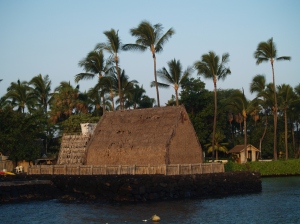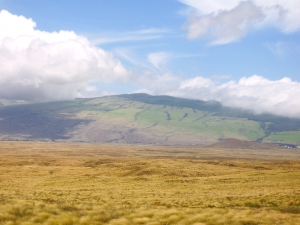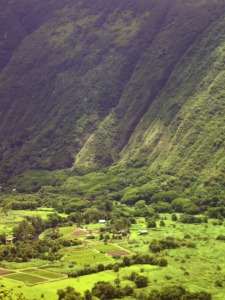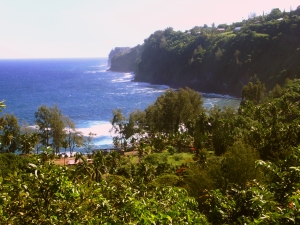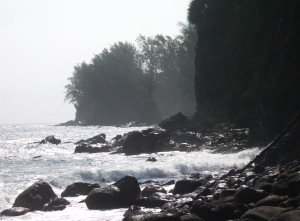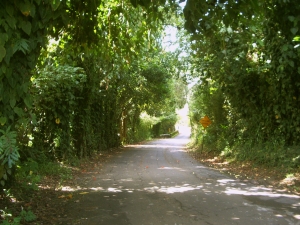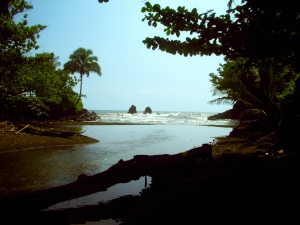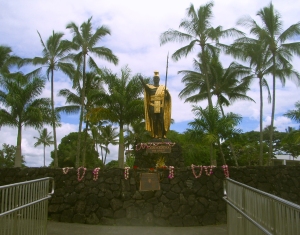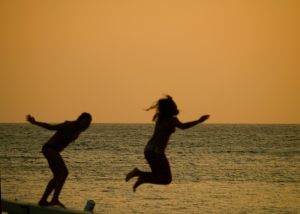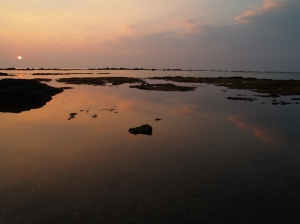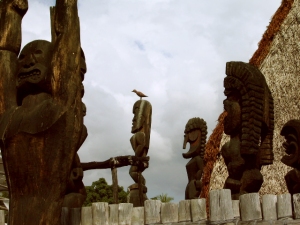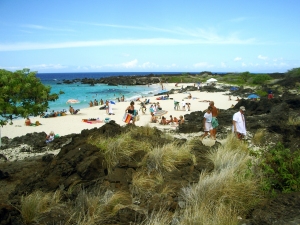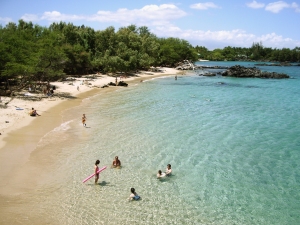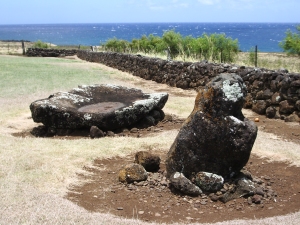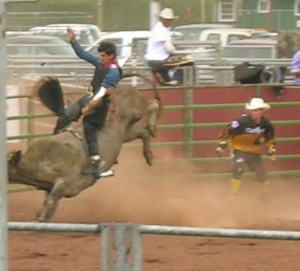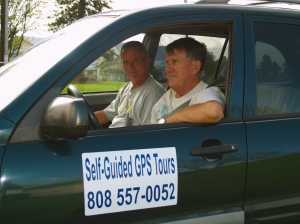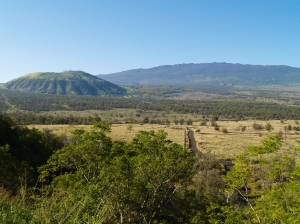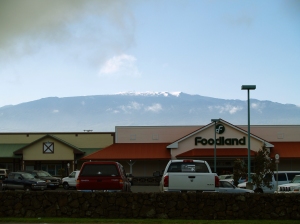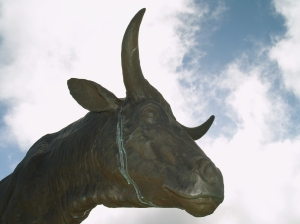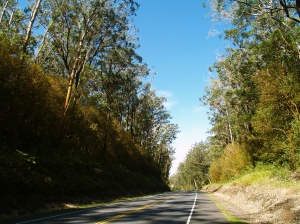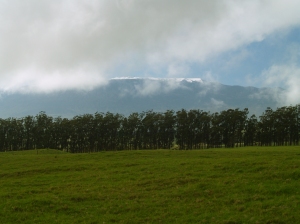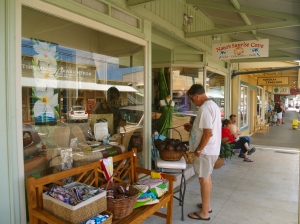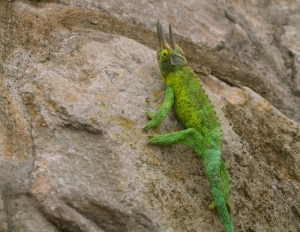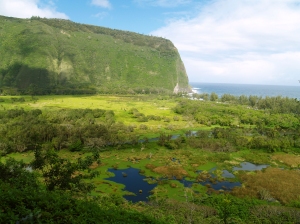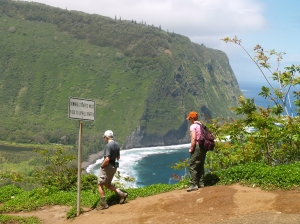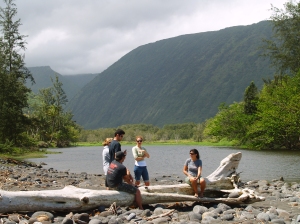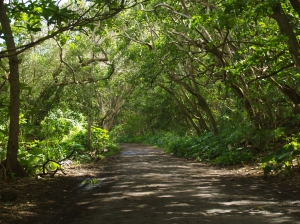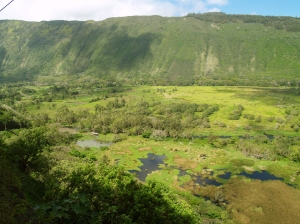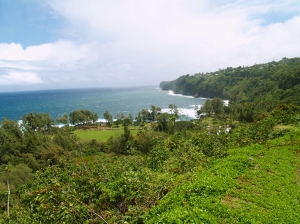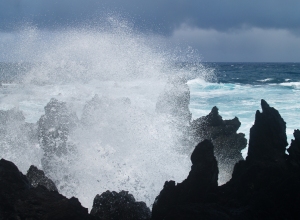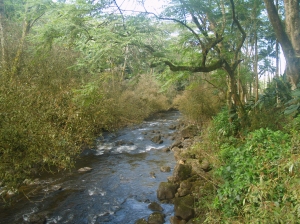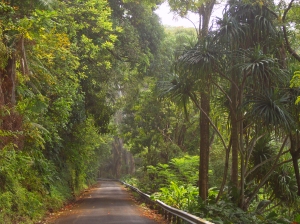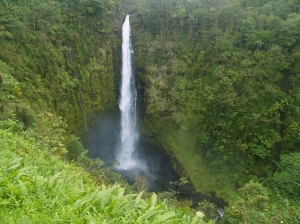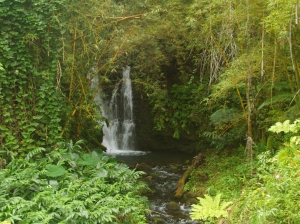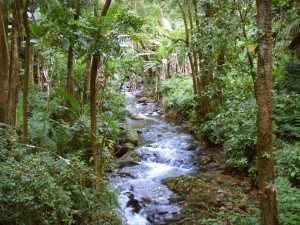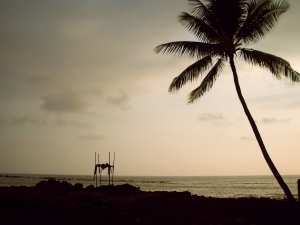Kona to Hamakua Coast: Spectacular Waterfalls, Incredible Canyons and Lush Rainforest
Approximate minimum time start to finish (to see every site): 9 hours.
This day offers spectacular waterfalls, lush rainforest and beautiful canyons, shopping, dining and 2-one hour hikes.
Highway 190 leaves Kona north to Waimea then on to Honoka'a and Waipi'o Valley in about 1 1/2 hours driving. The photos from the valley overlook are postcard gorgeous and Honoka'a has cute shops and restaurants. After a 1 hour drive, seeing several sites along the Hamakua Coast, Highway 220 branches to Akaka Falls. Follow the paved loop through the tropical jungle and smell exotic flowers along this not-to-be-missed, easy 1 hour waterfall hike. Be sure to stop in Honomu for the unique shops. Proceeding south on Highway 19, ten minutes, is the Pepe'ekeo Scenic Drive (4 Mile). Along this road is Onomea Bay Trail, a 1 hour round trip hike, down to the ruggedly picturesque coastline. From there it's 20 minutes to Rainbow Falls, Hilo's signature waterfall. Hilo is the largest city on the island and has numerous shops, malls, museums, restaurants and beaches, such as Richardson Beach, near downtown. From Hilo, it is a 2 1/2 hour drive back to Kona.
Leg 1) In Kailua Kona, start at Ahu’ena Heiau, take Palani Road east to Hwy 190; take Hwy 190 through Waimea to Honoka’a.
Ahu'ena Heiau and Kamakahonu Beach
Centuries ago the inhabitants of this region built a series of sacred temples, or heiaus, which were originally used for the purpose of sacrificing human beings to their war god, Kuka’ilimoku. This particular archeological site is called Ahu’ena Heiau, which in Hawaiian means “Hill of Fire”.
Built originally in the 15th century and rededicated by Kamehameha the Great in the early 1800s as the main temple of his capital, the current structures seen at Ahu’ena Heiau were re-built in 1975 under the auspices of the Bishop Museum with financial help from the Hotel King Kamehameha and are constructed to 1/3 the original scale. There are restrooms and showers located on the pier near the beach. Adjacent Old Kailua Town is a treasure of shops, restaurants and aloha.
Waimea Town and Cowboy Country
Snuggled between Mauna Kea and Kohala Volcano in Hawaii's scenic mountain heart, seemingly always shrouded in mist and chilly, Waimea is definitely Hawai’ian cowboy country. Although jeans and flannel shirts appear to be the town uniform, Waimea is very sophisticated, boasting some of the finest shopping and restaurants and the most modern hospital on the island.
From Waimea, Highway 250, the Kohala Mountain Road, spills beautifully through mountain, upland meadow and forest to the "Old Hawaii" town and artist community at Hawi.
Additionally, the cattle industry centers in Waimea. In 1793 British Navigator George Vancouver presented cows to King Kamehameha which were allowed to roam free and soon became a problem. Shortly after horses were brought to Hawaii in 1804, Kamehameha recruited California vaqueros, whom Hawai'ians called "paniolo"--a corruption of the word "Espańol"--to control the wild herds, and the generations-old ranching lifestyle here was born.
The vaqueros also brought their guitars and their love of music. A deeply musical people, the Hawaiians were intensely interested in these, the first stringed instruments they had seen. They quickly learned to work-out their own tunings, called "slack key guitar", which more suited the style of their indigenous music.
Honoka’a Town
Built in the era of sugar great plantations and left culturally and economically isolated after the industry collapse, until recently Honoka’a was content to drowse along through the decades. A boom in real estate and return of vital human energy to the area has made a literal renaissance of the town. It boasts numerous wonderful restaurants, gift and boutique shops and the highest density of antique shops on the island. Be sure to stop to explore a little on your way to or from Waipi’o Valley…it’s a fun, happening kind of place and always steeped with aloha.
Driving north or south out of Honoka'a, remnants of old sugar mills, fields and wild cane can still be seen. When Captain Cook arrived in 1778, only wild sugar cane was growing; at its height in the mid-1960's one in 12 people were employed in the sugar industry which produced in excess of a million tons of sugar annually. Though the business is gone, what is left are the people who once worked the fields and mills. The melding of the rich cultures of Japanese, Chinese, Filipinos, Portuguese, and others is what gives today's unique Hawaii lifestyle its sweet flavor.
Leg 2) At Honoka’a, turn north on Hwy 240 to Waipi’o Valley.
Waipi’o Valley
Waipi’o Valley is arguably the most magical place on the Big Island. The steep canyon walls and verdant fields of the valley floor, the mile long black sand beach and numerous immense waterfalls that line the valley walls all call out to the visitor for exploration.
Always listed among the most beautiful spots in the State of Hawai’i, this valley is as hauntingly lovely as it is difficult to see in its entirety.
Tours down into the valley in vans, on horse drawn wagons and ATVs can be booked in Honoka’a. Over-flights in fixed wing aircraft and helicopters also offer fine venues from which to see this amazing piece of Hawai’i. Hiking down and wandering the immense black sand beach, exploring the ironwood copses and sand dunes and discovering the hidden waterfalls is also a popular way to see the canyon. Although the hike down is only a little over 1 mile and a thousand feet elevation loss, the climb back up is sweltering in the ferocious sun and heat. Think twice before hiking down. Facilities at the Scenic Overlook include a pavilion and restrooms; there are none within the valley itself.
Leg 3) From Waipi’o Valley, return to Honoka’a on Hwy 240, get on Hwy 19 and head south.
Leg 4) Take Hwy 19 south to Laupahoehoe then Kolekole, continue south to Hwy 220; west on Hwy 220 to Honomu, then to Akaka Falls.
Laupahoehoe Park
A place of great beauty, of awesome displays of oceanic power and of tragic memories, Laupahoehoe Park stands where 20 children and teachers at the Laupahoehoe School were killed in the tsunami of 1946. Inside the park on a small hill overlooking the jetty is a memorial stone inscribed with the names of those who died in the tsunami. There are restrooms, campgrounds, picnic facilities, pit barbecues and ball fields. The pounding of the raw ocean on the jetty reminds one that not every beach in Hawaii is made for swimming, however the fishing here is excellent.
Kolekole Beach County Park
The river you saw magnificently jumping with such abandon off the cliff at Akaka Falls ends its journey to the sea by sluicing through this Koa tree-filled canyon and smashing into the surf at Kolekole Beach Park. A wild beach, a jungle canyon and a waterfall swimming hole are fun things to do at Kolekole Park.
The visitor is advised to admire the ocean, but not go in. The currents and tides are lethally treacherous here.
Facilities at Kolekole Beach Park include picnic pavilions and tables, pit barbecues, showers, restrooms and drinking water.
Akaka Falls
There is a reason that Akaka Falls rates as the most visited tourist site on the Island of Hawai’i. Simply put, the 420 foot, free falling plunge of clear water down a fern festooned cliff is an amazing and beautiful site. Leaving the parking lot, the paved loop trail of about one mile, winds through a wonderful jungle of exotic flowers, ferns, orchids, ginger and bamboo. Two smaller falls are also seen along the way to the stellar Akaka Falls. Akaka Falls has restrooms but no other facilities.
When visiting Akaka Falls, be sure to save some time to explore the shops, galleries and cafes of Honomu on the way back to the highway; it’s unlike anywhere you’ve ever been before…guaranteed.
Leg 5) Return Hwy 220 through Honomu to Hwy 19, then south on Hwy 19 to Old Mamalahoa Highway (or Kulaimano Road to Old Mamalahoa Hwy); this is the Pe’epekeo Scenic Drive. South and east on Old Mamalahoa Hwy to Onomea Bay; continue on Old Mamalahoa Hwy south to southern jct with Hwy 19.
Pepe'ekeo Scenic Drive
Located just a few minutes north of Hilo on Highway 19, this “Old Road through Old Hawai'i”, a four-mile-half hour scenic wander, parallels Highway 19 but is removed worlds away from the traffic and hustle along the main road. Rolling along old cane fields, jungle-canopied in places, passing waterfalls and crossing creeks, the Pepe’ekeo Scenic Drive is a special treat for the visitor who may be thinking they waited a century too long to visit Hawai'i. On a sunny day, on a rainy day, it doesn’t matter; this scenic drive is a joy. There are no services available along the scenic drive.
Onomea Beach Trail
Only a few miles north of tame and sedate Hilo Bay, Onomea Bay is subject to the full fury and magic of the open Pacific Ocean. Rugged, jagged, majestic, the wickedly sculpted cliffs along the bay belie the easy 15 minute walk down to the beach. Accessible to most walkers of even marginal condition, the trail leads alongside a botanical garden (be sure not to wander through any of their gates unless you are a paying customer) and meanders down to the canyon mouth, past a tiny waterfall at the end of the stream and to the beach. There are awesome opportunities for photo
Leg 6) South on HWY 19 to Hilo; get on Hwy 200 (Waianuenue Avenue), head south-southeast to Rainbow Drive and Rainbow Falls.
Hilo Town
Beautiful but wet, metropolitan but decrepit, bustling but laid back, Hilo is a lovely, maddening, heartbreaking, addictive study in contrasts. In can rain all day long for 50 days in a row, yet when the sun does shine, the views of Mauna Loa and Mauna Kea from the Liliuokalani Gardens, or of Hilo Bay as you drive down from the mountains, or the rain-forest and waterfall choked gulches with lovely beaches along the highway north of town, make Hilo one of the most truly, achingly-lovely spots on earth.
More laid back and sleepier than bustling Kailua Kona, Hilo is the largest town on the island, and the county seat. The Imiloa Astronomy Center of Hawaii, Tsunami Museum, Lyman House Missionary Museum and the Panaewa Rainforest Zoo are all wonderful places to learn about various aspects of Hawaii. There are numerous shopping districts, two large malls and the Historic Old Hilo downtown shops to browse through, a variety of sprawling green parks, a fabulous tropical arboretum right downtown and a mile-long black-sand beach fronting the bay to explore. Hilo's Farmer's Market is a "must see" for any visitor who is spending time on this side of the island.
Rainbow Falls and Wailuku River Park
The subject of recent and ancient legend, Rainbow Falls is the lovely emblem of Hilo town. The characteristic wishbone shape of Rainbow Falls is best seen at moderate river flows…too little water and only a single drizzle remains, too much runoff and the falls merge into a single, roaring flume. At any time, however, it’s a beautiful place and worthwhile to visit. The rainbows within the falls are best seen in the mid to late morning. Follow the trail to the left along the river bank to delightful swimming and wandering; please note, however, that swimming in rivers and near falling water is dangerous. Don’t go in if the current is swift or if recent rains have swollen the river.
Restrooms are by the parking lot and a souvenir shop is located across the street.
Leg 7) Return Hwy 200 (Waianuenue Road) to HWY 19, then east on 19 to Jct with Kamehameha Ave; Kamehameha Ave east to jct with Kalanianaole Ave to Richardson Beach Park.
Richardson Beach Park
Richardson Beach Park, with its towering palms, fresh water pools, delightful surf, secluded and calm tidepools, lawns and general ambiance of tropical paradise, is almost certainly very close to what most visitors expect from Hawai’i—hence it popularity.
Views of Mauna Kea at sunrise and sunset from this beach are unparalleled. The snorkeling here along the small black sand beach is the best of the Hilo area and the surf is a busy mix of beginner to intermediate level waves. Restrooms, showers, water, picnic tables and a lifeguard round-out the amenities of this wonderful place. There is also a Hawai'i County Police Department substation here.
Leg 8) Return on Kalanianaole Ave to Kamehameha Ave to Hwy 19; take Hwy 19 north to Honoka’a and jct with Hwy 190; drive Hwy 190 west to Kailua Kona.
For more information on traveling to Hawaii in general and touring the Big Island in particular, please also visit www.tourguidehawaii.com and www.lovingthebigisland.wordpress.com. For information about the author, please go here.
All media copyright 2009 by Donald B. MacGowan; all rights reserved.
